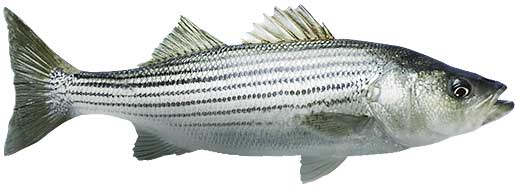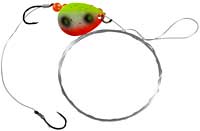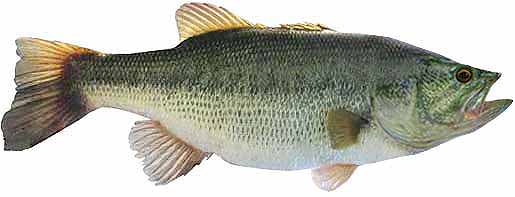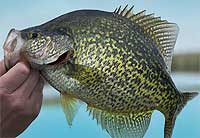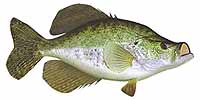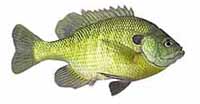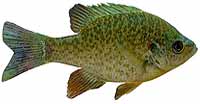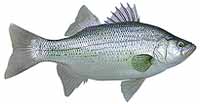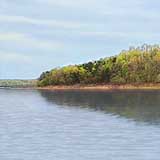Fishing Report For Norfork Lake, AR
By Rick Seaman
August 16, 2025
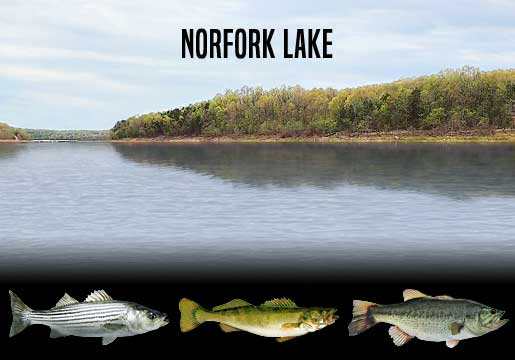
Fishing Reports
Popular Fish Species Norfork Lake, AR
Striped Bass
Current Report: Good To Very Good
SUMMER. In Summer, stripers hang out in deeper water during the heat of the day and feed close to the bottom, 40 feet deep or deeper. Morning often draws the stripers to much shallower water. Look for them around the 10 to 20-foot range as they feed on shallow, roaming schools of threadfin shad and gizzard shad. Walking topwater baits are catching some nice striped bass early. Being successful at fishing for stripers in deeper water during Summer is a matter of locating schools of bait, and the wolf packs of stripers are likely to be nearby. Fish finders, and sonar electronics, are a big help in locating these roaming schools. Nice stripers are being caught while trolling or drift fishing. Spoons, blade baits, crankbaits, live bait and cut bait are all effective here.
FALL. In Fall, stripers are drawn back to the upper end of the lake, to inflowing water from the North Fork River, and other feeder creeks. Look for deeper sections in the upper river channels, and fish them thoroughly. The river channel out in front of Henderson, the junction entering Float Creek, and around Cranfield are popular spots for catching big stripers.
WINTER. In Winter, stripers again hang out in deeper water and feed close to the bottom, often as deep as 80 feet. Warm, sunny afternoons occasionally draw stripers shallower, to around 20 feet deep as they feed on roaming schools of threadfin shad and gizzard shad. Locate schools of bait, then look for stripers close by. Fish finders, and forward facing sonar, are a big help in locating these roaming schools. Nice stripers are being caught while drift fishing with live bait or cut bait. Spoons, blade baits, and heavy hair jigs are all effective this time of year. Due to the stripers slower metabolism this time of year, anglers are triggering more strikes by working baits more slowly.
SPRING. Once water temperatures reach the mid 60's, it's time for stripers to spawn. There are reports of many stripers nearing the 50-pound range caught here. The lake is loaded with stripers averaging 5 to 20 pounds. In Spring, work the upper end of the lake where there is inflowing water, and into major creek channels. If they spawn, they will lay eggs in flowing water. Look for deeper holes in the river channels, as they are a good holding place for stripers.
Walleye
Current Report: Good To Very Good
Spring and Fall are the best seasons for weekend anglers to catch walleye, as they spend a considerable amount of time in shallow water.
SUMMER. Currently the water temperature is in the mid 70's, and walleye fishing is good. Throughout Summer, early in the morning, and from dusk to long after dark are good times to catch walleye. At those times they move shallow to feed in low-light conditions. Night fishing has been good, as well. The rest of the time they are cruising flats and creek channel edges, where they are more difficult to locate and catch. When the bite is slow, minnows, grubs and nightcrawlers, fished just off the bottom are catching walleye, as are flutter spoons.
FALL. Fall brings cooler temperatures to shallow water, drawing walleye and baitfish into 15 to 30 feet of water. Jigs, swimbaits, spoons, crankbaits, jerkbaits, and spinnerbaits are all historically good for catching walleye this time of year. Expect the bigger walleye to be slightly deeper than the majority of the school.
WINTER. This Winter fishing for walleye was pretty good in deep pools and around the dam area, 40 to 60 feet deep. They primarily feed on threadfin shad, gizzard shad and other small fish, staying close to the bottom. Blade baits, jigs tipped with minnows, spoons, and worm harness spinners, are all working while trolling or slow drifting.
SPRING. Anglers will begin moving to the upper end of the lake, where anglers are finding walleye in the shallows, especially rocky areas and inlet channels. Here they will spawn once the water warms to the mid to high 40's. Afterwards, they move to shallow points, flats, shoals and ledges, just off shore and nearby their spawning locations. Bright colored jigs, tipped with minnows or nightcrawlers typically catch them in 5 to 12 feet of water. Spinnerbaits, jerkbaits and crankbaits are also working when walleye are up shallow.
Largemouth Bass
Current Report: Good
SUMMER. Water temperatures are in the mid to high 70's, so summer patterns are in full swing. Bass are feeding shallow early and late in the day, where they are being caught on topwater, crankbaits and swimbaits. Largemouth bass here feed on gizzard shad, threadfin shad, small sunfish and crawfish. During the hotter parts of the day, they are being caught on points, channel edges, and ledges 15 to 35 feet deep. Good reports are coming from anglers fishing around main lake points and ledges. Night fishing with jigs and big worms is popular with locals.
FALL. When Fall arrives, bass here will follow schools of baitfish into coves and shallow bays where topwater, jerkbaits, swimbaits, and slow-rolled spinnerbaits have been successful in prior years. As deeper water cools, bait and bass move out to ledges, channel edges, points, and humps where flutter spoons are often the ideal bait.
WINTER. Winter will isolate them around deeper structure, flats, points and creek channels. They can be found from 20 to 50 feet deep. Here they hold, feeding less frequently, awaiting warmer water to return in Spring. Flutter spoons, jigs, and shaky heads are popular baits.
SPRING. Once water temperatures rise into the low 60's, largemouth will move from deep wintering holes, to shallower water just outside spawning areas. Jerkbaits, spinnerbaits, jerkbaits, and vibrating jigs typically get bites just away from the shoreline. At this time they are preparing for the spawn. Once water warms into the mid to high 60's, they will move into 1 to 4 feet of water, and create nests, then lay their eggs. Immediately afterwards, females move to deeper water and males remain to guard the eggs, and then the fry. After a couple weeks, the males also move to slightly deeper water. Deep-diving crankbaits, vibrating jigs, plastic worms and swimbaits are catching bass during this period.
Fishing Video
Fish species to fish for...
Guide to fishing for largemouth bass, spotted bass, channel catfish, blue catfish, flathead catfish, black crappie, white crappie, walleye, bluegill, redear sunfish, white bass, striped bass and hybrid striped bass at Norfork Lake in Arkansas.
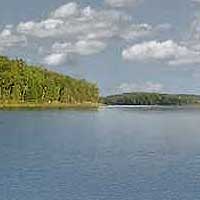
Norfork Lake is a 22,000-acre lake with over 500 miles of shoreline. Striped bass, crappie, walleye, bass, bream and catfish draw a lot of attention from local anglers. There is some access for fishing from the bank at parks and public assess areas.
Primary fish species to catch
Click images for fishing tips and details about each species.
Today's Weather & Forecast
Fishing Boat Rentals
Click here for fishing boat rentals.
Public Boat Launch Ramps & Landings
Click here for boat ramps.
Marinas
Click here for marinas.
Fishing License
Click here for a Arkansas Fishing License.
Map - Fishing & Camping Areas
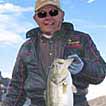
Rick Seaman is a fishing enthusiast with over five decades of fishing experience, a retired tournament fisherman, author of numerous published articles on fishing, and co-author of the book "Bass Fishing - It's not WHAT you throw, It's WHERE you throw it".
Contact Information
Panther Bay Marina
151 Panther Bay Loop
Mountain Home, AR 72653
870 492-5151
Fishing lakes in each state
081725
Norfork Lake, AR Report
ARKANSAS


Fishing for bass, crappie, walleye, bream and catfish in northern AR.


